
In the enchanting woodlands of Wisconsin, a symphony of rhythmic drumming fills the air. Here, among the towering trees and echoing forests, a diverse array of woodpecker species have made their home. From the bold and fiery red-headed woodpecker to the elegant and patterned black-backed woodpecker, Wisconsin’s woodpecker population is a testament to the beauty and adaptability of these remarkable birds. Read on for an exploration of the woodpeckers that grace the landscapes of Wisconsin, as we investigate pictures, learn how to make identifications, and discuss where exactly they live. Here are 9 woodpeckers in Wisconsin.
What is a Woodpecker?
Description

The pileated woodpecker is one of the largest woodpeckers in the world!
©iStock.com/Harry Collins
Woodpeckers belong to the family Picidae, which is part of the order Piciformes. This family consists of approximately 240 species. Interestingly, woodpeckers have many incredible adaptations and behaviors that allow them to drum, chisel, and forage food on trees. To aid in foraging behaviors, they typically have a stout body and a sturdy beak adapted for drilling wood. Species range in size typically between 6 to 19 inches in length. Also, woodpeckers have strong legs and special toes. Two toes face forward and two face backward, allowing the bird to grip tree trunks and branches. Their stiff tail feathers also help prop them up on trees.
Woodpeckers commonly display vibrant and diverse plumage that varies between species. Some have black-and-white patterns, while others may exhibit red, yellow, or green hues. Many woodpeckers have distinct markings such as spots, bars, or patches on their heads or bodies. Males of certain species often have additional ornamentation such as bright red or yellow crests.
Distribution
Woodpeckers have a global distribution with various species inhabiting diverse ecosystems. They live in North and South America, Europe, Asia, and Africa. Within these continents, the habitats they occupy include forests, woodlands, savannas, grasslands, and even urban areas. Factors that influence their distribution include food availability, tree density, and nesting opportunities. Some species are endemic to specific regions while others have wider ranges.
1. Red-headed Woodpecker
Identification

The red-headed woodpecker has a vibrant crimson head that helps with identification.
©vagabond54/Shutterstock.com
The red-headed woodpecker (Melanerpes erythrocephalus) is a medium-sized woodpecker with a striking appearance. It has black and white wings, a vibrant red head, and a white underbelly. Juveniles of this species have a mottled pattern on their heads that gradually transitions to the vibrant red of adulthood. Both sexes average between 7.5 and 9.8 inches long with an average wingspan of 16.7 inches.
Distribution
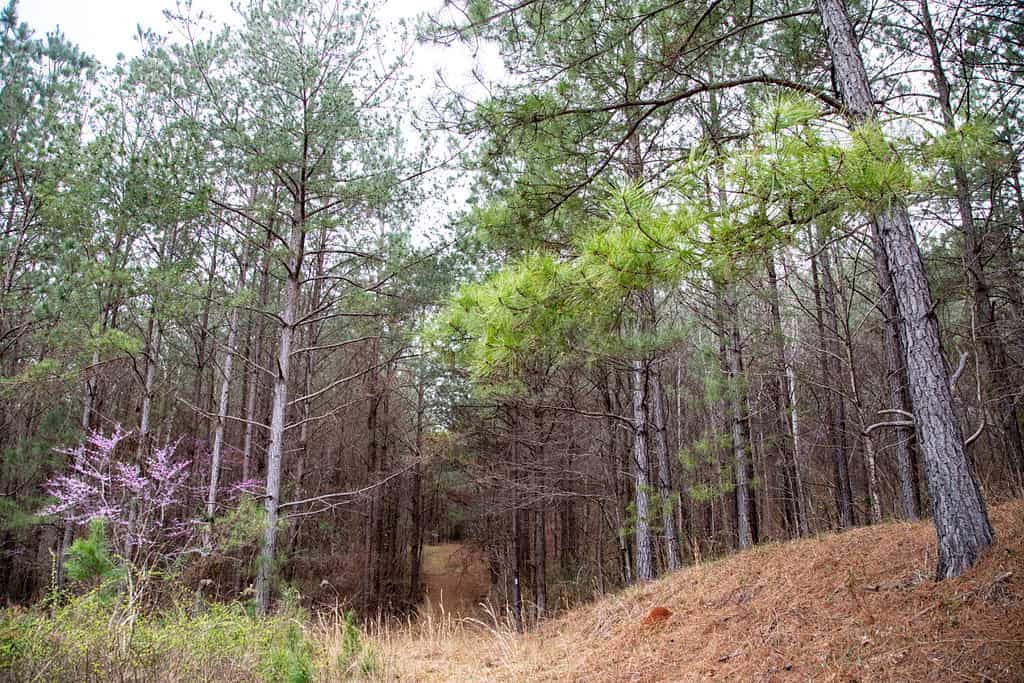
Wooded areas and mixed forests are ideal habitats for the red-headed woodpecker.
©mjplocki/Shutterstock.com
Red-headed woodpeckers live in various regions of Wisconsin. In southern Wisconsin, they can be found in Dane County, Jefferson County, Walworth County, Rock County, and Waukesha County. Reports suggest woodpeckers inhabit woodlands, parks, and nature reserves throughout these counties. In addition, in central Wisconsin, red-headed woodpeckers can be found in the forests and open woodlands of Adams County, Portage County, Marathon County, and Wood County.
2. Red-bellied Woodpecker
Identification

The red-bellied woodpecker has a red belly, but it is often hidden.
©rck_953/Shutterstock.com
The red-bellied woodpecker (Melanerpes carolinus) is a medium-sized woodpecker species. It is approximately 9 to 11 inches in length and has a wingspan of 13 to 17 inches. Despite its name, its red belly is often hidden. The most prominent feature of the bird is its red crown and nape. This creates a beautiful contrast with the bird’s black and white barred back and wings. The face and underparts are a pale greyish or beige color, but the belly is often a blush, pink shade. Males typically have a slightly brighter crimson crown.
Distribution
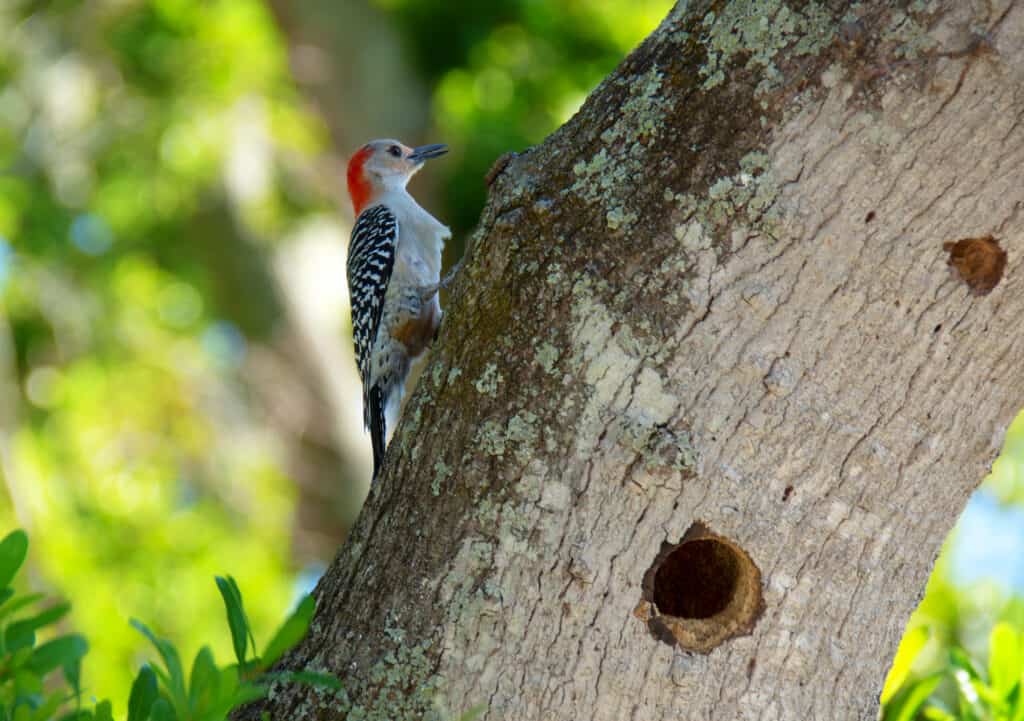
Red-bellied woodpeckers can also be tracked by looking for the holes they bore into trees.
©Michael O’Keene/Shutterstock.com
The red-bellied woodpecker can be found in the forests, woodlands, parks, and suburban areas of several counties in Wisconsin. In southern Wisconsin, you may find these birds in Dane, Milwaukee, Waukesha, Jefferson, and Rock Counties. In central Wisconsin, red-bellied woodpeckers live in Adams, Portage, Marathon, and Wood Counties. They inhabit mixed woodlands, riparian, lake, and forest habitats.
3. Yellow-bellied Woodpecker
Identification

Yellow-bellied woodpeckers, or yellow-bellied sapsuckers, have a yellow hue on their breast.
©iStock.com/impr2003
To identify a yellow-bellied woodpecker, look for distinct characteristics such as its size, coloration, and unique markings. The yellow-bellied woodpecker, also known as the yellow-bellied sapsucker (Sphyrapicus varius), is a medium-sized woodpecker species. It measures approximately 7-8.5 inches in length. The bird has a black head with a white or pale yellow forehead and a red crown patch in males. Its back is black, and its wings display black and white barring. The most prominent identifying feature is its yellow or pale yellowish belly, which stands out against the rest of its body. The yellow-bellied woodpecker also has a barred pattern on its flanks and a white rump.
Distribution
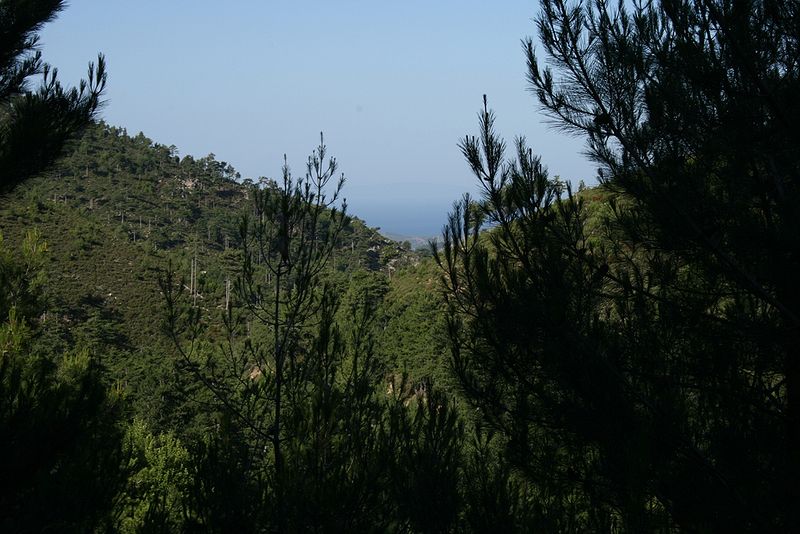
Coniferous forests are suitable habitats for yellow-bellied woodpeckers.
©Sten Porse / CC BY-SA 3.0 – License
Yellow-bellied woodpeckers live primarily in the northern and central parts of Wisconsin. In the north, they may occupy areas such as Bayfield County, Ashland County, Vilas County, and Oneida County. Here, they inhabit mixed forests, coniferous forests, and wooded areas near lakes and rivers. As for central Wisconsin, these woodpeckers live in Marathon County, Portage County, and Wood County. They prefer woodlands, forest edges, and areas with a mix of deciduous and coniferous trees.
4. Downy Woodpecker
Identification
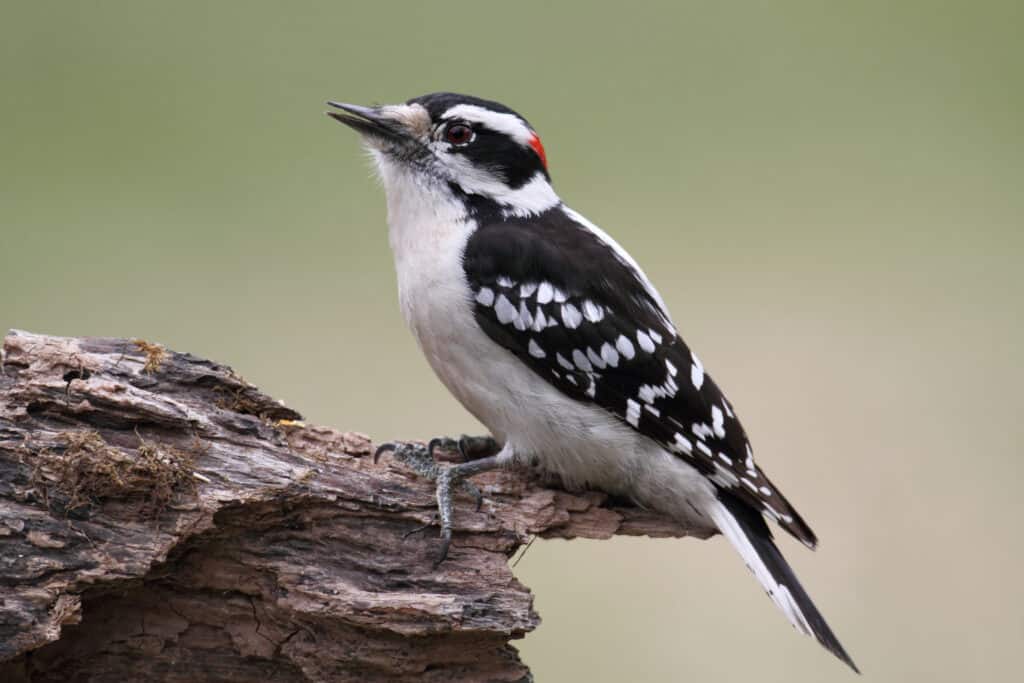
The male downy woodpecker has a distinct red spot on the back of its head.
©Steve Byland/Shutterstock.com
The downy woodpecker (Picoides pubescens) is a small woodpecker species with distinct morphological characteristics. It measures approximately 5.5 to 6.75 inches in length, making it one of the smallest woodpeckers in North America. The downy woodpecker has a wingspan ranging from 9 to 12 inches. It features a black-and-white pattern, with a black back, wings, and tail. The outer tail feathers are white and display black spots. The head of the downy woodpecker has a white underside, but the male has a small red patch on the back of its head. The outer flight feathers show white spots, creating a distinctive spotted pattern when the wings are spread.
Distribution
The downy woodpecker is widespread throughout the state of Wisconsin. It is a year-round resident and is present in Wisconsin during all seasons. They can easily be found in forests, woodlands, parks, and residential areas. Regions with abundant mixed forests, deciduous woodlands, and riparian areas can provide favorable conditions for this species.
5. Hairy Woodpecker
Identification
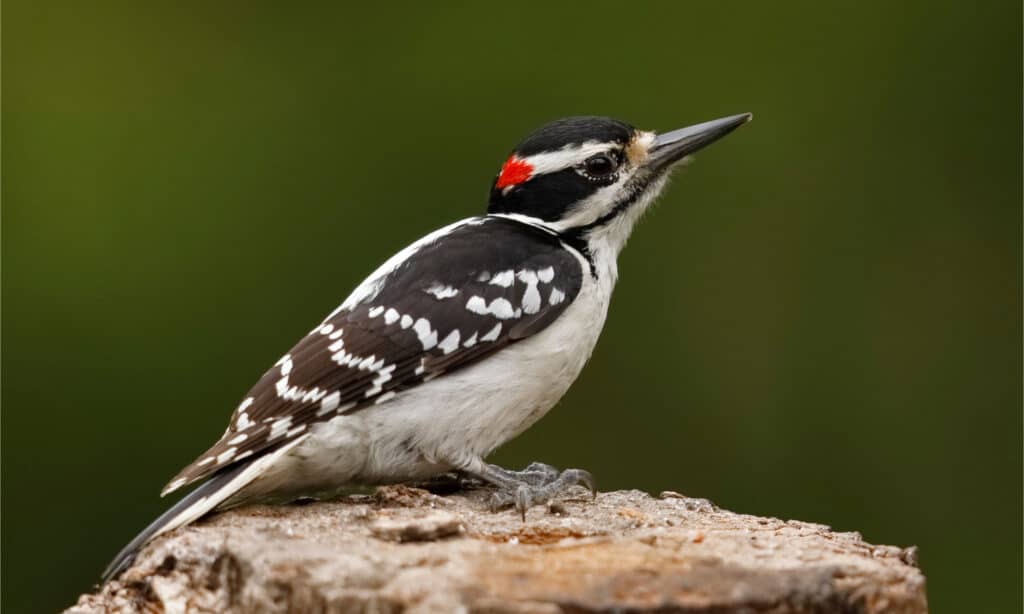
Hairy woodpeckers have square heads and long bills.
©Brian Lasenby/Shutterstock.com
The hairy woodpecker (Picoides villosus) is a medium-sized woodpecker species with distinct physical characteristics. It measures approximately 9.25 to 10.5 inches in length, slightly larger than the similar-looking downy woodpecker. The hairy woodpecker has a wingspan ranging from 13 to 17 inches. It features a black-and-white pattern, with a black back, wings, and tail. The outer tail feathers are white and display black bars. The head of the hairy woodpecker is solid black without any markings. Its bill is relatively longer and stouter compared to the downy woodpecker.
Distribution
Hairy woodpeckers live throughout Wisconsin. They inhabit a variety of habitats, including forests, woodlands, parks, and residential areas with mature trees. Hairy woodpeckers are year-round residents, observable in all seasons. Look for them foraging on tree trunks and branches excavating cavities for nesting sites and insect larvae.
6. American Three-toed Woodpecker
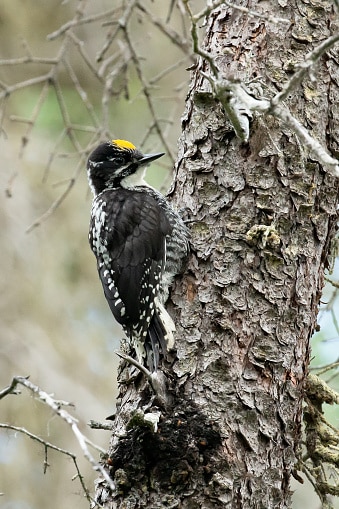
The American three-toed woodpecker has a distinguishing white stripe down its back.
©Warren A Metcalf/ via Getty Images
Identification
The American three-toed woodpecker (Picoides dorsalis) is a medium-sized woodpecker species with distinct identifying characteristics. It measures approximately 8.5 to 9.5 inches in length. The wingspan of the American three-toed woodpecker ranges from 16 to 18 inches. This woodpecker has a black back and wings, with white barring on the wings. Its head is mostly black, but it lacks the prominent red crown patch seen in other woodpecker species. The American three-toed woodpecker displays a white stripe running down the center of its black back, which distinguishes it from the similar-looking black-backed woodpecker. One of the notable features of this woodpecker is its three-toed foot arrangement, unlike most woodpeckers that have four toes. Males and females have similar coloration and patterns.
Distribution
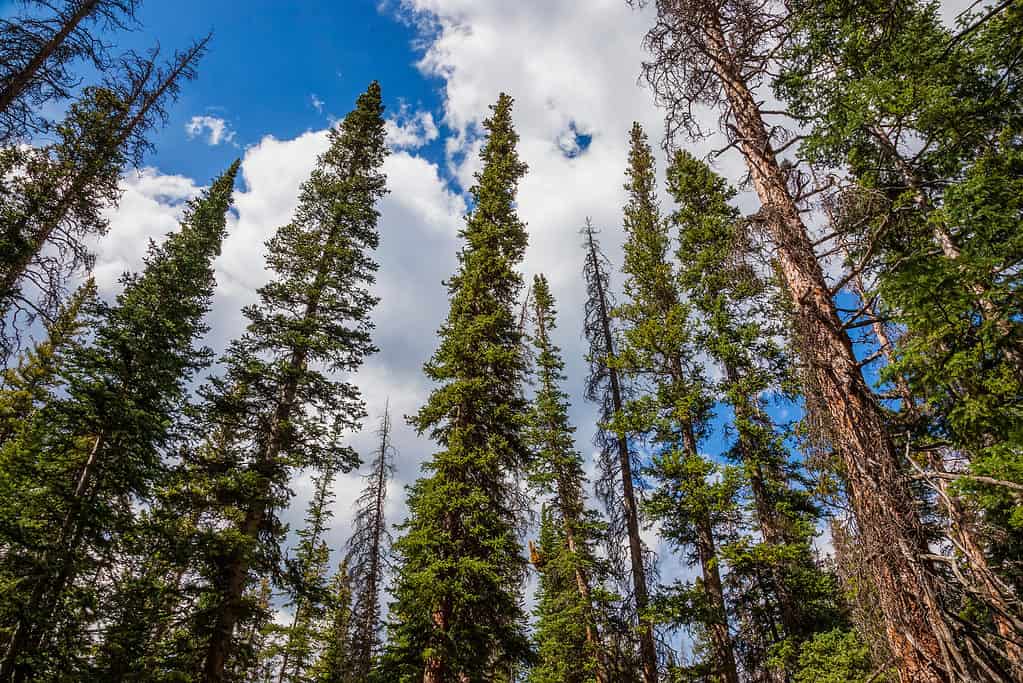
Spruce and fir trees provide a preferable habitat for the American three-toed woodpecker.
©Igor Kovalenko/Shutterstock.com
The American three-toed woodpecker can be found in specific regions of northern and central Wisconsin, primarily within coniferous forests. It tends to prefer mature forests with a significant presence of spruce, fir, and pine trees. Areas such as the Chequamegon-Nicolet National Forest, Northern Highland-American Legion State Forest, and the forests of Bayfield and Douglas Counties are known to have suitable habitats for the American three-toed woodpecker. These woodpeckers have specialized foraging behavior, targeting tree trunks infested with wood-boring insects. To have the best chance of observing American three-toed woodpeckers in Wisconsin, it is recommended to explore remote and less disturbed areas with extensive coniferous forests, paying attention to signs of their presence, such as distinctive feeding holes on tree trunks and the unique three-toed footprints they leave behind in the snow.
7. Black-backed Woodpecker
Identification
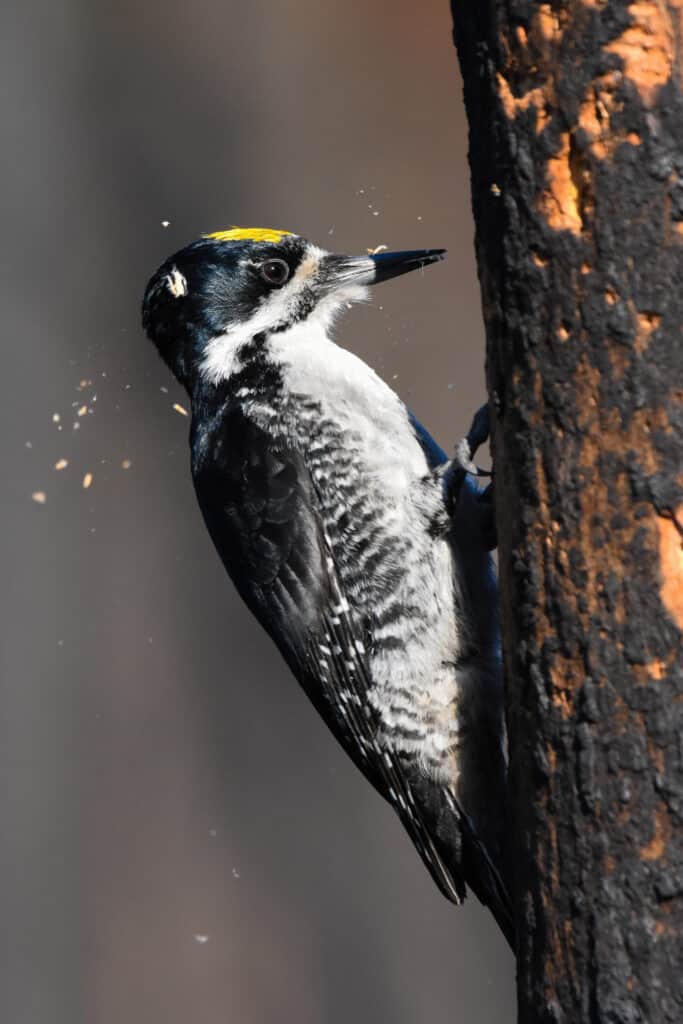
Male black-backed woodpeckers have a distinct yellow patch on their head.
©Carrie Olson/Shutterstock.com
The black-backed woodpecker (Picoides arcticus) is a woodpecker species with several distinctive identifying characteristics. It is approximately 9.5 to 10.5 inches long and has a wingspan between 16 and 17 inches. The black-backed woodpecker showcases a black back, wings, and tail, hence its name. It has a white face, with a black crown extending down to the nape of the neck. Males display a yellow patch on their foreheads. One of the most notable features of this woodpecker is its white upper back, which distinguishes it from the American three-toed woodpecker. Its underparts are mainly white, and it has black and white barring on its wings.
Distribution

Regions that have been subjected to forest fires make suitable habitats for black-backed woodpeckers.
©iStock.com/bradscottphotos
The black-backed woodpecker exists in some regions of northern Wisconsin, particularly in areas that have experienced forest fires or other forms of recent disturbance. These woodpeckers are well adapted to post-fire habitats and are often associated with burned or recently disturbed coniferous forests. Regions such as the Chequamegon-Nicolet National Forest and the forests of Bayfield and Douglas Counties are known to have suitable habitats for the black-backed woodpecker.
8. Northern Flicker
Identification
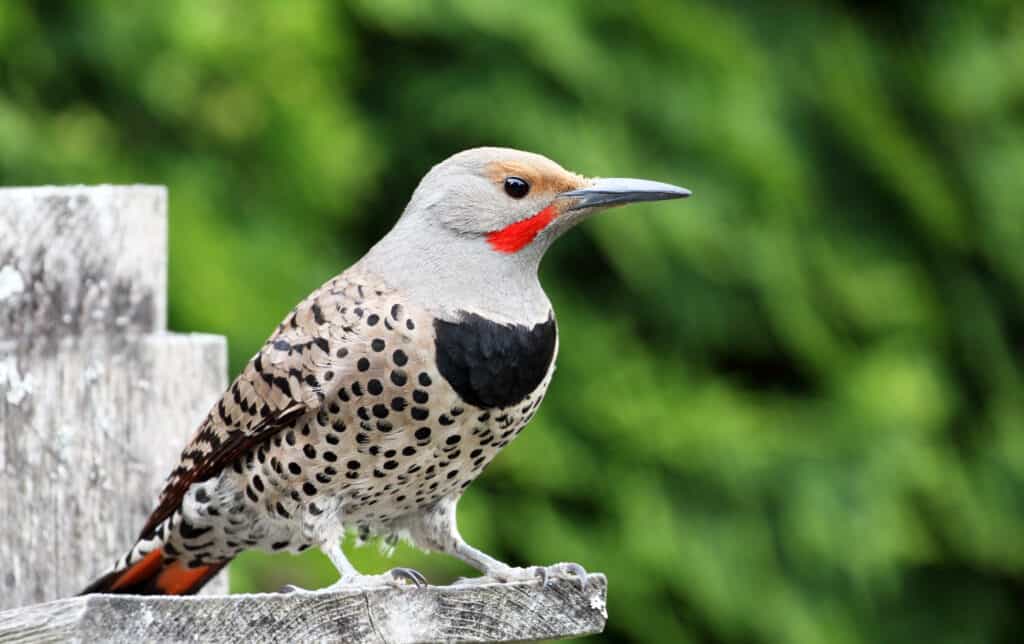
This male northern flicker displays the species’ unique coloration and pattern.
©Birdiegal/Shutterstock.com
The northern flicker (Colaptes auratus) is approximately 11 to 14 inches in length, making it one of the larger woodpeckers in North America. The wingspan of the northern flicker ranges from 17 to 21 inches. This woodpecker displays a combination of colors, featuring a brownish-gray back and wings with black barring. Its underparts are pale, with a beige or light brown breast and belly. The head of the northern flicker is notable for its unique pattern, with a gray face and a black crescent-shaped mark on each side of the neck. The male northern flicker has a black or red mustache mark, also known as a “mustache stripe,” while the female lacks this mark. Another distinctive feature is the yellow or red patch on the underside of the wings, which is visible in flight.
Distribution
Northern flickers are widespread in Wisconsin. They inhabit a variety of habitats, including open woodlands, forests, forest edges, and even suburban areas with suitable nesting sites and food sources. Northern flickers favor mixed habitats that include open areas with trees, such as parks, fields, and residential neighborhoods. They often feed on the ground by foraging for ants and other insects in the soil. Look for them on lawns, in open areas with scattered trees, or near dead snags where they may excavate nesting cavities.
9. Pileated Woodpecker
Identification
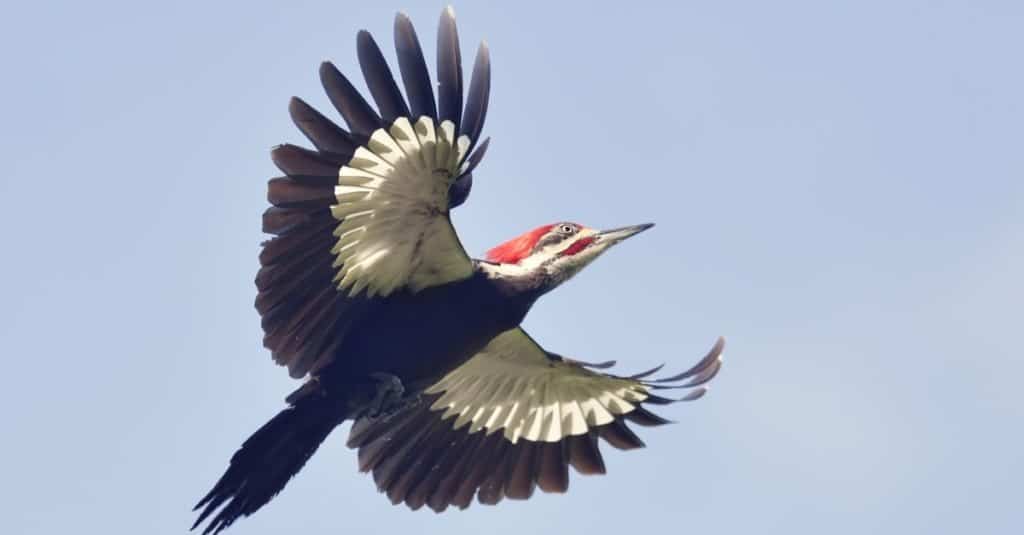
Pileated woodpeckers have beautiful red, black, and white colorations.
©Svetlana Foote/Shutterstock.com
The pileated woodpecker (Dryocopus pileatus) is a large woodpecker species approximately 16 to 19 inches in length. Impressively, the wingspan of the pileated woodpecker ranges from 26 to 30 inches. The pileated woodpecker is therefore one of the largest woodpeckers in the world. This woodpecker displays a striking black body with white stripes on its face and neck. The head is predominantly black with a prominent crest, and males have a red crest that extends from the bill to the nape of the neck. In addition, the pileated woodpecker has a long, chisel-like bill, ideal for excavating large rectangular holes in trees in search of insects and creating nesting cavities. Its underparts are black, and the wings exhibit white underwing linings that are visible during flight.
Distribution
Pileated woodpeckers are a fairly common and widespread species in the state. They inhabit a variety of forested habitats, including mature and old-growth forests, wooded areas near water bodies, and forested parks. Pileated woodpeckers prefer larger tracts of forest with a mix of deciduous and coniferous trees, as these habitats provide suitable nesting sites and abundant food sources such as insects and tree-dwelling ants. Look for them in areas with ample dead or decaying trees, as they often excavate large rectangular cavities in search of insects or to create nesting sites. Pileated woodpeckers are less frequently found in urban or suburban areas but can occasionally be spotted in larger wooded neighborhoods with mature trees.
Other Species of Woodpeckers
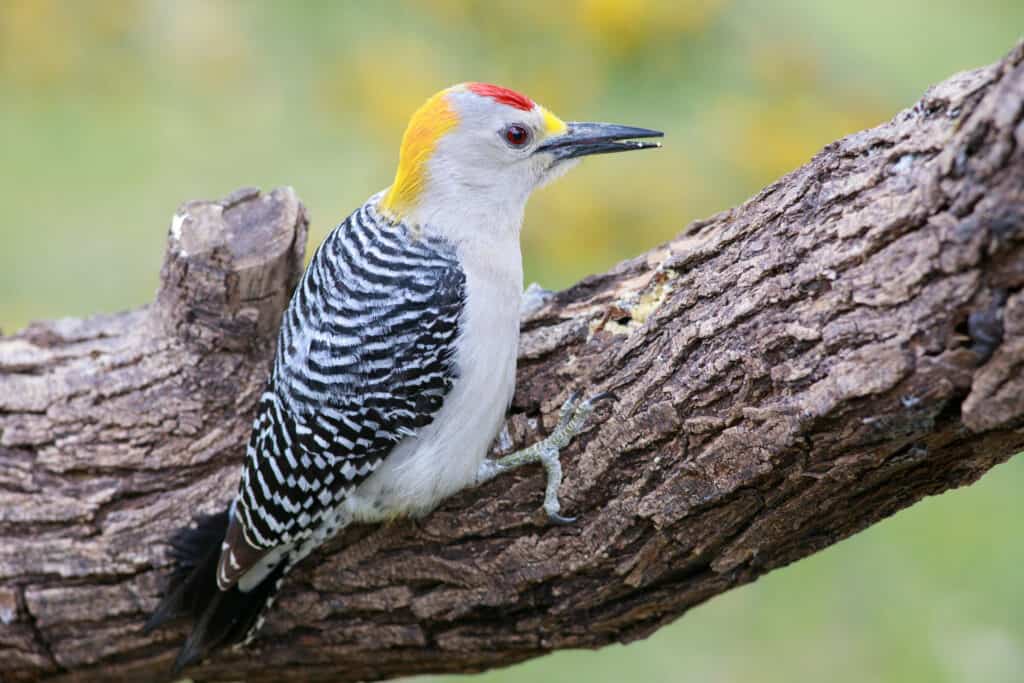
Golden-fronted woodpeckers have unique colorations that include white, red, yellow, and black patterns.
©Raul Baena/Shutterstock.com
Another fascinating species, the golden-fronted woodpecker (Melanerpes aurifrons), boasts a captivating color palette that showcases its unique beauty. With a vibrant golden-yellow patch on its forehead, contrasting against its black back, wings, and tail, this woodpecker captivates the eye. The underparts of the golden-fronted woodpecker feature a combination of white and black barring, while its cheeks and nape exhibit a touch of red. In terms of size, this woodpecker measures approximately 8.5 to 9.5 inches in length, making it a medium-sized species. Its wingspan ranges from 16 to 17 inches, allowing for graceful flight as it navigates through its preferred habitat of woodlands, brushlands, and open forests across its range in the southwestern United States and northern Mexico.
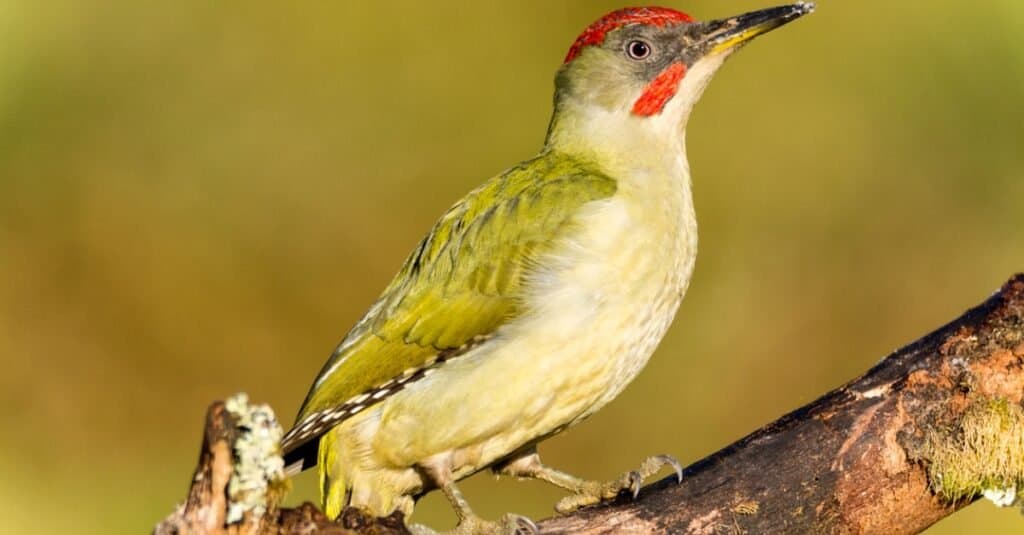
European green woodpeckers have a unique green color unlike any species found in Wisconsin.
©Studioimagen73/Shutterstock.com
A second additional species is the European green woodpecker (Picus viridis). Its plumage is primarily composed of vibrant shades of green, blending with hints of yellow on the belly and olive tones on the wings and tail. The male and female green woodpeckers have similar coloration. In terms of size, they measure approximately 11 to 12 inches in length, therefore making them a medium-sized woodpecker species. Their wingspan spans around 16 to 17 inches, enabling graceful flight as they move through their preferred habitats of woodlands, parklands, and open areas across Europe, including the British Isles. The European green woodpecker’s distinctive appearance, with its striking green color, notable size, and well-proportioned wings, make it a captivating sight in the natural landscapes it inhabits.
Summary of 9 Woodpeckers in Wisconsin
| Woodpecker | Prominent Feature | |
|---|---|---|
| 1 | Red-headed Woodpecker | Vibrant red head |
| 2 | Red-bellied Woodpecker | Red crown and nape |
| 3 | Yellow-bellied Woodpecker | Pale yellow belly |
| 4 | Downy Woodpecker | The male has a red spot on the back of his head |
| 5 | Hairy Woodpecker | Solid black head and long bill |
| 6 | American Three-toed Woodpecker | Has three toes instead of the usual four |
| 7 | Black-backed Woodpecker | The males have a yellow patch on their heads |
| 8 | Northern Flicker | The yellow or red underside of wings visible during flight |
| 9 | Pileated Woodpecker | The size of this bird is its prominent feature – it is one of the largest woodpeckers in the world |
The photo featured at the top of this post is © rhfletcher/Shutterstock.com
Thank you for reading! Have some feedback for us? Contact the AZ Animals editorial team.






